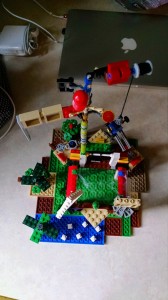3 to 10 Nashville:
Everyone is first handed a game map with an area traced out to represent “Nashville” (Community Lawn vicinity) and a random face card to identify which team they’re on. Those given a red card are the law, and those given a black card are the outlaws. Amongst each team, one person is designated as the team leader – either the bandit for the outlaws, or the sheriff for the law.
Everyone is then given 6 cards of their team’s color (ranging from values of 3 to 10) to be used in the game. The idea is that the members of the two teams duel each other with these cards in a series of individual 1 on 1 shootouts that allow them to accumulate cards for their leaders to use in a final shootout. A normal shootout works like this:
Both people choose a card from their hand to use in the shootout. No matter the outcome, both of these cards are “spent” and immediately ripped up (think of the cards as bullets that aren’t reusable). Whoever had the higher card is the winner and gets to choose a card at random from the other player’s hand to be kept and saved for their leader. If the shootout ends in a tie, the cards just get ripped up and no one gets to draw a card.
Players can prowl freely in the area marked on the map. Upon encountering someone from the opposing team, a shootout may happen. One person first asks, “Are you from Nashville?” to which the other replies, “Them’s fighting words!” and then the shootout commences. No two people can duel against each other more than once. After 30 minutes of walking around and dueling, everyone reconvenes in the lawn. In the final shootout, each leader gets to use all (or maybe it was just X number) of the cards that their team won for them. Each winning shot earns that leader a point. Players’ unused cards can be used to help deflect the opposing leader’s shots. The leader with the most points at the end of the shootout wins the game for their team.
It was a pretty long game without a lot of action happening for most of it. My team split up into smaller groups and just wandered around separately. Besides the few shootouts, I found that we spent most of the time just walking and talking about our personal lives. Also, since we were only given 6 cards, we could duel at most only 6 times, and that’s only if we kept winning. Supposing that each shootout takes less than a minute, that leaves about 24 minutes of downtime.
At one point, we saw a bunch of tough looking guys. Someone in my small walking group instinctively yelled out, “Are you from Nashville?!” They gave us a quizzical look. Some people got very into character. I think the flavor and roleplaying aspect definitely made the game. The best strategy seemed to be to play your highest card(s) first to prevent others from stealing your good cards. And once we were left with only crappy cards, a bunch of us suicided by dueling with the other team and forcing them to sacrifice their cards in the duel. Was that the right strategy? Or should we have saved our crappy cards for protecting our leader? Not sure, but there wasn’t much to do, so I just used them in the shootouts anyway.
You Win:
Each person takes a card. How to Play from the card:
Subtly try to achieve the goal on the back of this card. If you achieve your goal, YOU WIN. Celebrate by firing your party popper(s) and shouting “I WIN!” If you tell someone your goal, try too hard to win, or someone catches you trying to win, YOU LOSE. Get another card and try again.
It was a very background-level game. I didn’t stay for long after getting this card, but I can imagine someone just shoving this card in their back pocket and playing it for the duration of the night. I don’t know what other tasks there were, but mine said:
YOU WIN IF… someone takes off an article of clothing. It is worth 2 Party Poppers.
I’m guessing that all of them were things that could be potentially awkward if done un-subtly. Since your targets can be non-players and there’s no strict structure to the game/whom you can interact with, there doesn’t seem to be much motivation to win – it’s just you against your tiny square card. It’s an interesting idea for a game though. Everyone in your proximity immediately becomes a player in some sense without even being aware of it.






















